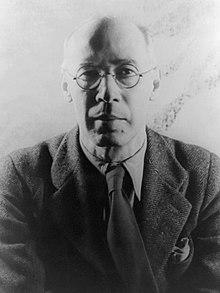Henry Miller | |
|---|---|
 Miller in 1940 | |
| Born | Henry Valentine Miller December 26, 1891 New York City, U.S. |
| Died | June 7, 1980 (aged 88) Los Angeles, California U.S. |
| Occupation | Writer |
| Period | 1934–80 |
| Genre | Roman à clef, philosophical fiction |
| Notable works | |
| Spouse |
|
| Children | 3 |
| Signature | |
Henry Valentine Miller (December 26, 1891 – June 7, 1980) was an American novelist, short story writer and essayist. He broke with existing literary forms and developed a new type of semi-autobiographical novel that blended character study, social criticism, philosophical reflection, stream of consciousness, explicit language, sex, surrealist free association, and mysticism.[1][2] His most characteristic works of this kind are Tropic of Cancer, Black Spring, Tropic of Capricorn, and the trilogy The Rosy Crucifixion, which are based on his experiences in New York City and Paris (all of which were banned in the United States until 1961).[3] He also wrote travel memoirs and literary criticism, and painted watercolors.[4]
- ^ Shifreen, Lawrence J. (1979). Henry Miller: a Bibliography of Secondary Sources. Rowman & Littlefield. pp. 75–77. ISBN 9780810811713.
...Miller's metamorphosis and his acceptance of the cosmos.
- ^ Mary V. Dearborn, The Happiest Man Alive: A Biography of Henry Miller, New York: Simon & Schuster, 1991, p 12.
- ^ "Henry Miller's novels censored and banned in US due to their sexually explicitly content," FileRoom.org, 2001.
- ^ "Gallery," henrymiller.info. Accessed August 31, 2013.